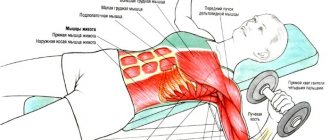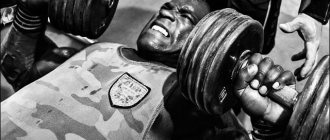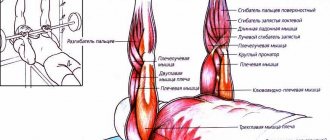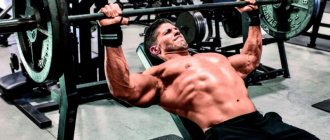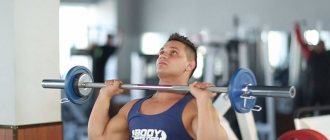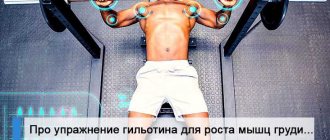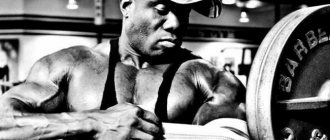Useful tips
The dumbbell bench press with a negative angle is one of the effective exercises for developing the lower part of the pectoral muscles. But, as practice shows, not all beginners need additional work on the lower chest. The classic bench press is enough.
However, there is a category of guys and girls who would like to correct the lower part of their chest. One way or another, the exercise is worthy of attention and even for the sake of variety it is worth including in the training plan.
Research shows that the dumbbell reverse press is one of the most effective exercises for working the lower pectorals, unlike the barbell. This is evidenced by experiments conducted in the USA using special equipment. It detects the electrical activity of muscles during specific exercises.
Here are some useful tips to help you perform the exercise:
- Choose the right weight. It should be comfortable to work with, without compromising the technique. As a rule, the ideal weight is 15-20% less than the classic horizontal bench press.
- When working with heavy weight, ask for backup. Have your partner squat down and help you squeeze by pushing your hands under your elbows.
- Try using supination and pronation. Supination involves turning the palms outward at the top point. Pronation - turning the palms inward towards each other at the lowest point.
- To make it easier to get up, take 2-3 breaths and then get up. This will normalize the pressure.
- Perform the movement through its full range. Only with full amplitude can the desired result be achieved.
- After each approach, it is definitely recommended to walk rather than stand still. This will avoid a huge rush of blood to the head due to circulation during movement.
Common Mistakes
- If you see that you cannot put the barbell on the racks in the bottom position, ask your partner to back you up before performing the exercise, since at any moment you may not have enough strength to lift the barbell and return it to its place.
- The exercise is classified as basic, so it should be one of the first to be performed.
- You should not pause at the bottom point, otherwise the emphasis will shift to the upper part of the pectoral muscle.
- Before starting the exercise, make sure that the bar or plates of the barbell do not touch the rack.
- The grip should not be too narrow, because then the elbows will not be able to move parallel to the body. As a result, instead of triceps, the exercise will train the chest muscles. Also, the grip should not be wider than 30 centimeters, in this case the exercise will turn into a regular bench press and will also put a load on the pecs.
- If you don't have a partner or a rack, start pressing from the bottom position.
- It is advisable not to use an alternative version of the grip due to the risk of losing control of the barbell.
- When you press the barbell up, try not to arch your lower back too much. Failure to follow this technique may result in serious injury.
- To improve grip on the bar, you can use chalk or special gloves.
- In the event of an emergency completion of an exercise, when you do not have the strength to lift the barbell and your partner is not nearby, place the barbell on your chest and hold it so that there is not too much pressure. Then, gently tilt one end of the bar so that the plates slide down. Hold the bar while sliding, as the other end may suddenly catapult down. When one end gets rid of the pancakes, do the same with the remaining pancakes.
When should it be included in a training program?
Generally, some people think that dumbbell exercises should be an afterthought. But that's not true. The dumbbell press is an even better alternative to the bench press.
Therefore, it is worth alternating dumbbells and barbells. This is how you can achieve maximum efficiency in shaping the upper pectoral muscles.
Here are a few training program options that you can use:
- At the beginning of training, as heavy pressing exercises. As an alternative to the barbell. And then perform isolated exercises.
- Perform after heavy bench presses with a barbell, as a finishing exercise for several approaches. And only then proceed to the isolated ones.
As practice shows, everything is individual. Some people prefer barbells, others use dumbbells. For some, forced repetitions, and for others, drop sets.
You can find the right technique only by practicing different variations. Therefore, as soon as you stop progressing, you should immediately make adjustments.
Separately, it is worth noting the fact that the weight used in the exercise will in any case be less than using a barbell. But, work with dumbbells should be carried out in the style of high-volume training. That is, the main task is not to set a strength record, but to work out the muscle efficiently.
Differences between dumbbell and barbell presses
The dumbbell bench press is a basic exercise in bodybuilding and powerlifting. This is what is included in powerlifting. To increase performance in barbell exercises (such as barbell clusters), the lifter performs dumbbell overhead presses. There are several differences in working with these sports equipment. You can also highlight a number of advantages of training with dumbbells:
- Safety. Exercising with a barbell in an empty gym is not safe. A heavy projectile can simply crush the athlete. If you exercise without a partner or trainer, and are not confident in your abilities, then use dumbbells. They can be easily lowered without causing injury.
- Range of motion. While working with a barbell, the athlete is limited to a clear trajectory of movement. The bar connects the two hands. Thus, the athlete cannot increase the amplitude of the set. When working with a barbell, the pectoral muscles will not receive the proper load. By performing exercises with dumbbells, you will increase the mobility of your joints. These movements are considered more natural for a bodybuilder's body.
- Opportunity to improve coordination of movements. Since the athlete will need to perform exercises with two sports equipment at once, he will be able to quickly and effectively improve the neuromuscular connection in the human body. The athlete will improve coordination of movements. This skill will also help in everyday life.
- Independence. Possibility to work two hands in turn. This feature of the dumbbell upward press is very important for athletes after an injury. Additional load on the target area will help eliminate imbalances in the development of different thoracic regions. During the barbell press, only the strong arm will do the main work. Using dumbbells, the bodybuilder plunges the right and left sides of the body equally. Thus, you can quickly eliminate the imbalance in strength indicators, as well as in the proportions of the athlete’s figure.
- Versatility. Using dumbbells, a bodybuilder can pump up all muscle groups in the body. Working with this sports equipment is safe and also very comfortable. The athlete has access to a huge number of both basic and isolation movements.
- Ability to use the projectile in different conditions. Dumbbells are small-sized sports equipment that take up little space. They are very easy to store at home. You can also take this projectile with you during long car trips. This way you can always effectively maintain your physical fitness.
In addition to the positive aspects, there are a number of disadvantages to performing the bench press with dumbbells. The most basic disadvantage can be considered the small weight of the shells. To exercise effectively, you must have a huge number of dumbbells. But the problem can be solved by purchasing a gym membership. Even in the simplest rocking chair you can find sports equipment that is suitable for your activities.
Bench training programs
The dumbbell press is an upper body exercise and is used in conjunction with triceps exercises. The principle of creating a workout in this case: first – exercises for the larger muscle, in our case the pectoral muscle (press), then – an exercise for the triceps. This order allows you to work your muscles as efficiently as possible.
You can combine the press with biceps exercises and combine exercises for the large pushing muscle group with the pulling group.
The chest-back combination is no less popular. In this case, the antagonist muscles work: the chest is responsible for pressing, and the back is responsible for traction. This combination will work well for two large departments at once.
Splits save a lot of time and allow muscles to recover. This approach can be used by both beginners and professionals. By varying the weight of the equipment, you can change the purpose of the training - the more weight, the more strength training you do, the less weight with more repetitions - the more resilient your muscles will be.
Unpleasant moments
Yes, there are some unpleasant points that are worth paying attention to:
High probability of injury due to negligence. Since the weight of dumbbells can be large, even with perfect technique, errors can occur.
Still, we are human, and we can do something carelessly. But in this exercise, the slightest jerk of a dumbbell with a large weight to the side can lead to ligament rupture, tendon damage and other injuries. Such injuries take a long time to heal and interfere with training.
Inability to gradually increase weight. This problem will only affect very healthy guys who work with extreme weights. For example, you want to go from a weight of 45 kg to a slightly heavier weight, for example 47 kg. But you can conclude that you can’t do this, because there are no pancakes that would help you gain exactly that amount of weight. You have to hang 50 at once, which is a bit much.
It's time to move on to discussing the technique to avoid injuries and learn useful tricks.
Technique for performing dumbbell head down presses
The exercise is intended for experienced trainees. It is not recommended for beginners to perform it, as it is necessary to first strengthen the pectorals and master the press technique. Only then begin to perform dumbbell downward presses.
To perform the exercise, you will need a special bench with a negative inclination angle. Unfortunately, this is not available in all halls. But, fortunately, you can replace it with a bench for pumping your lower abs.
When performing the exercise, you will definitely need a partner who will serve dumbbells. You can try to take them yourself, but it will be extremely inconvenient.
- Starting position: approach the bench, sit on it, place your legs behind the stops to achieve the tightest fixation. The pelvis and lower back are pressed tightly to the bench, the shoulder blades are brought together. Take the dumbbells from your partner with your arms lowered to your shoulders. Having taken them, we bring them up to outstretched arms so that they are perpendicular to the floor.
- As you inhale: in a slow and controlled movement, lower your arms to the lower chest, trying to stretch the pectoral muscles as much as possible. You can even pause at the bottom for a second to achieve maximum stretch. When lowering the dumbbells, your elbows should move out to the sides and down.
- As you exhale: return to the starting position with the same slow and controlled movement. At the same time, at the top point you do not need to fully extend your arms to relieve the load on the elbow joint and triceps.
As a rule, in the classical variation, 3-4 sets of 10-12 repetitions are performed. But everything is determined on an individual basis.
Depending on the preferences and wishes of the trainee. Therefore, the best solution would be to schedule a training program with an experienced and competent trainer.
Execution technique
The technique is not complicated, but it is still worth taking it seriously. This way you will minimize the incidence of injury and be able to achieve results in a shorter time. Before you start the exercise, you need to prepare your workplace.
Preparation for the exercise and starting position.
- Set the bench press to the angle you want.
- Place dumbbells next to a bench.
- Lift the dumbbells and sit on a bench, placing them on your legs.
- Lie on a bench, lifting dumbbells with your legs and arms and placing them at the same level as your deltoids.
- The back should be pressed, the shoulder blades should be brought together as much as possible.
The chest is protruded forward, there is a slight deflection in the lower back. Feet stand firmly on the floor, creating additional support.
This will be your starting position.
Performance:
- As you exhale, forcefully straighten your arms up. At the same time, at the top point, bring the dumbbells slightly towards each other. At the same time, do not straighten your elbows completely, so as not to engage the triceps in the work.
- As you exhale, lower the dumbbells down, spreading them slightly to the sides.
- Repeat the specified number of times.
That's the whole technique for pressing dumbbells on an incline bench. The main thing is not to rush, your movements should be controlled. At the top point, tighten your pectoral muscles as much as possible, and at the bottom, pause to properly stretch them. When it comes to the number of sets, it's best to choose a mid-range rep range. Also use 1-2 warm-up approaches. That is, in reality we get 1-2 warm-up and 3-4 working sets of 6-12 repetitions.
Errors
In any exercise, there is one way to do the movement correctly and many ways to do it incorrectly.
Pay attention to popular mistakes and try to avoid them
Heavy weight
When a person takes on too much weight, from the outside it looks like this:
- The lifting of the barbell is not carried out smoothly, but with the help of a jerk and bending of the whole body.
- The bar swings and moves not along a given path, but at random.
- The weight is lowered very quickly, the bar falls on the chest and is absorbed from it.
Naturally, in this case the technique will be dangerous for muscles, joints and ligaments. You can easily dislocate your shoulder. And the lower you lower the bar, right down to your stomach, the greater the load on your shoulders. And the triceps, on the contrary, will lose it.
Incorrect elbow position
The degree of load on the triceps depends on the position of your elbows. Elbows should be pressed to the body and move strictly up and down, but not to the sides.
In this case, you will achieve maximum load on them.
Using an Incline Bench
There is no point in working at positive angles. This will not change the load on different areas of the triceps. Therefore, there is no need to work on an incline bench. Just move it to a horizontal position. Or, alternatively, use a bench with a slight negative incline.
Using locks of different weights
This subtlety is not entirely obvious, but still.
It is important that the locks on the bar weigh the same. A difference of 200-300 grams is enough to make it possible to lose balance, especially in the last repetitions, when there is practically no strength left.
When you do a barbell lift, this difference will mean that one arm will be able to press the weight, but the other will not. As a result, the bar will move to the right or left. Be careful and select the same locks on both ends of the bar.
Breath
Don't complicate your life - breathe correctly.
Exhalation occurs through the mouth, and inhalation occurs through the nose. This is because you can exhale more forcefully through your mouth than through your nose. This means you can lift the weight more powerfully.
Too light weight
Select the weight so that the last 2-3 repetitions of each approach are difficult for you. If you have any strength left, the weight is too light. This is only permissible at first, when you start training. After a month of introductory training, you need to gradually increase the weights to failure in order to effectively spend time in the gym.
What not to do
The first is to check how much you can squeeze out at once. The close grip bench press can be dangerous for the elbows and shoulders if used at maximum weights. The triceps press is needed for pumping muscles, and not for demonstration performances.
Secondly, work without a good warm-up. Always pre-warm up your muscles.
More articles on topics: Arms :: Triceps :: Barbell
Effective exercises:
- Incline Bench Press
- Technique for performing the California triceps press
- French press on the lower block - pumping the triceps while standing
Trainer Tip: Always warm up before training. It will prepare your muscles for stress and protect you from injury.
Exercise options
The first thing you can vary is the angle of the bench. The larger it is (the closer the body is to the vertical), the more the deltas are involved in the work and the less the pectoral muscles. The optimal angle for pumping up the chest is 30 degrees, but some athletes set the bench to 45, which also has a positive effect on progress.
For lovers of variety and experienced athletes - a negative bias. It shifts the load to the lower chest. If you believe the professionals, you need to change exercises regularly. And the ability to change the angle in this case is to your advantage. You don’t radically change the program, but at the same time you pump up your muscles as much as possible, using a minimum of equipment.
Another option is the alternate arm press. This will help you focus on a specific muscle group and practice technique. Although in terms of progress, of course, this is not so effective, and hands can be developed differently.
What muscles work
The dumbbell press gives the main load to the pectoralis major and minor muscles. It “shifts” if you change the position of the body:
- horizontally, the middle part of the chest is loaded as much as possible;
- when pressing dumbbells at an angle, it depends on the position of the head - in its natural form, the top works more, if you turn over, the bottom works more.
The anterior deltoids and triceps are somewhat less loaded. Stabilization of the body is provided by the muscles of the back (latissimus), abdominal press (abdominal), and buttocks. Maintaining the required immobility is more difficult than it seems, so they work and strengthen quite actively. The “stability” of the shoulders is very important when pressing. The serratus anterior and pectoralis major muscles are “responsible” for it, and the rhomboid and partially trapezius muscles on the back. The movement of the shoulder joints of the required amplitude is provided by the rotator cuff muscles and the biceps brachii muscle.
A position tilted at an angle of 30 degrees upward is more convenient in terms of maintaining balance than the horizontal position.
How to correctly perform 5 different options - photo
When performing this type of strength exercise, we primarily load the pectoral muscles, deltoids, as well as biceps and triceps.
Bench press or bodybar on a horizontal bench
This is a classic bench press. We work the middle part of the pectoral muscles. This is a great exercise for pumping up breasts for girls.
- Lie down on the bench.
- Take a bodybar or barbell with an overhand grip, hands slightly wider than shoulder-width apart.
- Remove the barbell from the rack and slowly lower it to your chest.
- After this, squeeze the weight upward.
How many times should I target? Perform three sets of eight repetitions.
Attention! Do not allow the barbell or bodybar to touch your chest.
Dumbbell bench press for girls on a horizontal bench
By performing this exercise, we work the pectoral muscles most effectively. Using dumbbells, you can better pump up your muscles, including small muscles that act as stabilizers. You can lift dumbbells from the floor yourself, or you can ask a partner to help.
Technique:
- Sit on a bench.
- Lower the dumbbells slightly above your chest, move your elbows to the sides: they should be located below your shoulders.
- The feet should be firmly on the floor with emphasis on the entire area of the foot.
- Press the dumbbells by straightening your arms, trying to bring the dumbbells together at the final top point.
Perform several sets of eight repetitions.
On an incline bench
When performing the exercise with your legs down, the upper part of the pectoral muscles is loaded. The dumbbell press, with your head lower than your legs, works the lower part of your chest muscles. When using small weights and high repetitions, it is excellent for removing chest fat.
Technique:
- Set the incline angle of the bench to thirty degrees.
- Take dumbbells from the floor, keeping your back straight and lifting by straightening your knees.
- Place the dumbbells on your thighs. Use force to lean back onto the bench while lifting your legs.
- Squeeze the dumbbells while straightening your arms. Maintain the natural curves of your spine and do not round your back.
Perform several sets of eight repetitions.
Close grip bench press for women
This movement maximally works the triceps in girls, and, therefore, allows you to tighten the muscles in the arms and effectively remove sagging skin.
- Lie down on a gymnastics bench. The hands are already closer than shoulder width.
- Remove the weight. Hold it up and place it in the middle of your chest.
- Slowly lower the bodybar or barbell, not reaching the chest.
- During the exercise, the elbows are constantly near the body.
- Push the barbell up.
We perform several sets of eight repetitions.
On fitball
The dumbbell bench press on a fitball allows you to work not only large, but also small muscles that are involved in maintaining balance.
Technique:
- Taking the dumbbells in your hands, we lie down on the fitball, placing our lower back firmly on the ball.
- Maintain balance with a straight back, pressing your feet firmly to the floor.
- We lift dumbbells, with our arms turned palms forward - this will allow us to focus on working the pectoral muscles without putting the load on the deltoid muscles.
- We lower and raise the dumbbells measuredly, slowly, bending and straightening our arms at the elbows.
We perform several sets of ten repetitions.
Peculiarity! Remember that it is contraindicated to use heavy weights when exercising on the ball. It is better to do the first workout without using weights.
Benefits of exercise
The dumbbell overhead press is one of the basic exercises in CrossFit. Let's take a closer look at what muscles work when bench pressing dumbbells and what are the benefits of it. The biggest advantage of the exercise is that thanks to it you can effectively load the pectoralis major muscles. The triceps and anterior deltoids also actively participate in the work. The biceps, as well as the latissimus dorsi, play the role of stabilizers during the exercise.
© Makatserchyk — stock.adobe.com
During movement, the athlete performs an upward pushing movement of sports equipment. The benefit of the dumbbell bench press for an athlete is that this exercise allows him to work out the chest area of the body well, as well as increase strength in other exercises. This exercise is perfect for beginners and will be a good basis for pumping up the chest. Working under the supervision of a trainer, a novice athlete can quickly take the first steps towards good shape. This exercise is a very effective way to start your training day.
Professionals need to perform dumbbell bench presses to increase strength in a standard barbell exercise. Also, experienced athletes need to regularly change their exercise program. This exercise will help diversify the process of pumping the pectoral muscles. You can work out at the gym using the superset method. Combine the pressing exercise with dumbbell flyes, as well as push-ups with wide arms. Perform several sets of different exercises without resting.
The dumbbell bench press on a horizontal bench is also suitable for women. Girls should work with a weight that is comfortable for them. Before lifting weights, you can build basic strength with regular push-ups.
Application
Intended for: Everyone, from beginner to professional.
When: At the beginning of a chest workout. Halfway through your workout, perform dumbbell bench presses and dumbbell flyes on a bench.
How much: 3-4 sets of 8-12 reps.
Sports instruction: No exercise stands next to the bench press in solving the problem of dramatically increasing the volume of muscle mass and power of the chest muscles. And although the center of the load here is directed to the middle of the chest, its lower and upper parts work at full strength. But know that this load distribution is good when you hold the bar with a wide grip. If the grip is strictly shoulder width, then the center of the load moves towards the top of the chest.
The muscles involved in the bench press are of great importance for many sports that involve push-ups, push-ups, punches and throws: boxing (lateral and direct blows to the body), tennis (hitting the ball with an open racket), discus throwing and shot put.
Breathing during exercise
Not only the bodybuilder’s well-being, but also the result of intense training depends on breathing. The correct technique will make the exercise easier and withstand a lot of weight, but impaired breathing will reduce the effort to nothing. It’s difficult to do without delay, but how to breathe correctly during this exercise?
It is important to consider that the delay increases blood pressure, which affects the person’s condition. When lowering the barbell, you need to inhale, in the middle of the amplitude - hold your breath and lower the projectile
Exhaling at the lowest point is not recommended, as this can affect the coordination of movements. Having touched the bar to your chest, you need to inhale and begin bench press with a wide grip, holding your breath. After which you should exhale powerfully, as if helping yourself with air.
When lowering the barbell, you need to inhale, in the middle of the amplitude - hold your breath and lower the projectile. Exhaling at the lowest point is not recommended, as this can affect the coordination of movements. Having touched the bar to your chest, you need to inhale and begin bench press with a wide grip, holding your breath. After which you should exhale powerfully, as if helping yourself with air.
Lifting dumbbells on a bench is present in any program for gaining muscle mass. Despite the popularity of the exercise, many beginners (and sometimes pros) do not know how to properly do a bench press with a barbell.
Attention is paid to absolutely everything: from the position of the bench and grip width to breathing or belay. Knowing all the subtleties of implementation, you will be able to achieve good results faster
Execution Sequence
1. Set the degree of inclination of the bench depending on which muscle segment you want to pump. 2. Install the barbell and equip it with working weight. Remember to use clamps on both ends of the projectile. If you are a beginner, perform bench presses with an empty bar. 3. Starting position: lying on a bench, hold the bar with an overhand grip above the body. 4. Only your palms should support the barbell, and place your thumb on top of it. 5. While inhaling, smoothly and at a slow pace lower the bar so that it touches the upper segment of the chest. 6. Straining your muscles, fix the position for 1-2 seconds. 7. While exhaling, use the muscles of the upper chest segment to squeeze the barbell and return to the starting position. 8. Don't throw the projectile onto your chest, but don't push it up uncontrollably either. Maintain a smooth, moderate pace throughout the exercise. 9. Repeat the barbell press at 45 degrees the desired number of times.
Bench Press Grip Width
Proper placement of the hands on the bar affects the placement of the forearms, which should be vertical at the bottom of the range. This is what will be the basis of the steam grip. But, despite this, there are other options for placing the hands on the barbell.
So, the bench press can be performed with a narrow and maximum wide grip.
- A narrow grip shifts the load to the triceps and the center of the pectoral muscles,
- and the bench press as wide as possible helps to better stretch and fill the chest muscles with blood.
When performing bench presses with a narrow grip, some athletes complain of pain in the wrist joints, as well as in the shoulders. This is due to an uncomfortable position (non-physiological for some) and curvature of the spinal column.
A wide grip engages the outer pecs and anterior deltoid, while reducing stress on the triceps. The danger of such a setup is the increased load on the elbow joints, ligaments of the anterior deltoid muscle and shoulder joint. Disadvantage: reduced amplitude.
